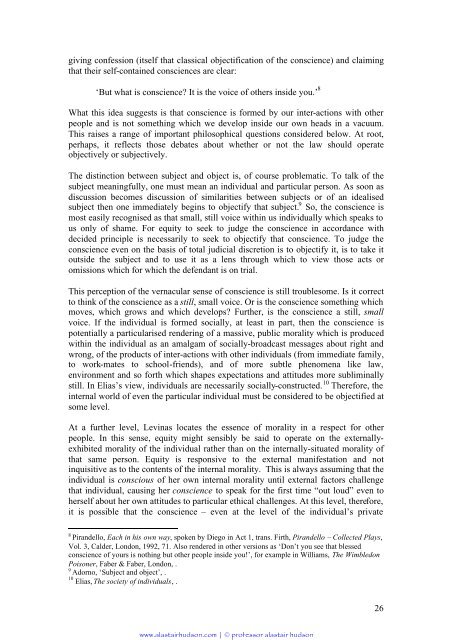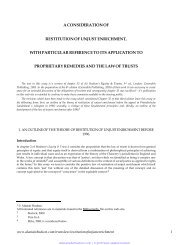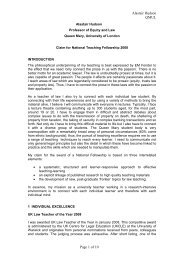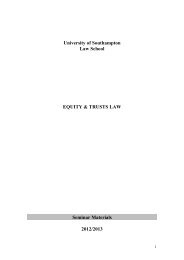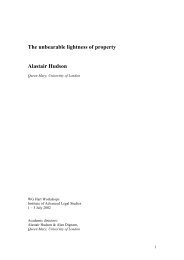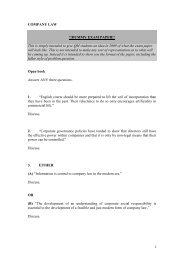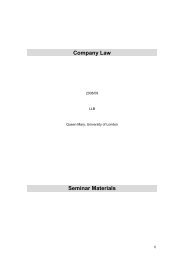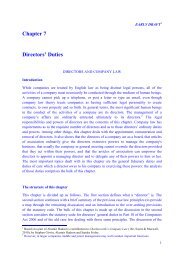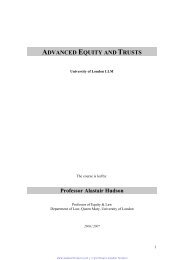England's dreaming equity, trust and conscience - alastairhudson.com
England's dreaming equity, trust and conscience - alastairhudson.com
England's dreaming equity, trust and conscience - alastairhudson.com
You also want an ePaper? Increase the reach of your titles
YUMPU automatically turns print PDFs into web optimized ePapers that Google loves.
giving confession (itself that classical objectification of the <strong>conscience</strong>) <strong>and</strong> claimingthat their self-contained <strong>conscience</strong>s are clear:‘But what is <strong>conscience</strong>? It is the voice of others inside you.’ 8What this idea suggests is that <strong>conscience</strong> is formed by our inter-actions with otherpeople <strong>and</strong> is not something which we develop inside our own heads in a vacuum.This raises a range of important philosophical questions considered below. At root,perhaps, it reflects those debates about whether or not the law should operateobjectively or subjectively.The distinction between subject <strong>and</strong> object is, of course problematic. To talk of thesubject meaningfully, one must mean an individual <strong>and</strong> particular person. As soon asdiscussion be<strong>com</strong>es discussion of similarities between subjects or of an idealisedsubject then one immediately begins to objectify that subject. 9 So, the <strong>conscience</strong> ismost easily recognised as that small, still voice within us individually which speaks tous only of shame. For <strong>equity</strong> to seek to judge the <strong>conscience</strong> in accordance withdecided principle is necessarily to seek to objectify that <strong>conscience</strong>. To judge the<strong>conscience</strong> even on the basis of total judicial discretion is to objectify it, is to take itoutside the subject <strong>and</strong> to use it as a lens through which to view those acts oromissions which for which the defendant is on trial.This perception of the vernacular sense of <strong>conscience</strong> is still troublesome. Is it correctto think of the <strong>conscience</strong> as a still, small voice. Or is the <strong>conscience</strong> something whichmoves, which grows <strong>and</strong> which develops? Further, is the <strong>conscience</strong> a still, smallvoice. If the individual is formed socially, at least in part, then the <strong>conscience</strong> ispotentially a particularised rendering of a massive, public morality which is producedwithin the individual as an amalgam of socially-broadcast messages about right <strong>and</strong>wrong, of the products of inter-actions with other individuals (from immediate family,to work-mates to school-friends), <strong>and</strong> of more subtle phenomena like law,environment <strong>and</strong> so forth which shapes expectations <strong>and</strong> attitudes more subliminallystill. In Elias’s view, individuals are necessarily socially-constructed. 10 Therefore, theinternal world of even the particular individual must be considered to be objectified atsome level.At a further level, Levinas locates the essence of morality in a respect for otherpeople. In this sense, <strong>equity</strong> might sensibly be said to operate on the externallyexhibitedmorality of the individual rather than on the internally-situated morality ofthat same person. Equity is responsive to the external manifestation <strong>and</strong> notinquisitive as to the contents of the internal morality. This is always assuming that theindividual is conscious of her own internal morality until external factors challengethat individual, causing her <strong>conscience</strong> to speak for the first time “out loud” even toherself about her own attitudes to particular ethical challenges. At this level, therefore,it is possible that the <strong>conscience</strong> – even at the level of the individual’s private8 Pir<strong>and</strong>ello, Each in his own way, spoken by Diego in Act 1, trans. Firth, Pir<strong>and</strong>ello – Collected Plays,Vol. 3, Calder, London, 1992, 71. Also rendered in other versions as ‘Don’t you see that blessed<strong>conscience</strong> of yours is nothing but other people inside you!’, for example in Williams, The WimbledonPoisoner, Faber & Faber, London, .9 Adorno, ‘Subject <strong>and</strong> object’, .10 Elias, The society of individuals, .26www.<strong>alastairhudson</strong>.<strong>com</strong> | © professor alastair hudson


